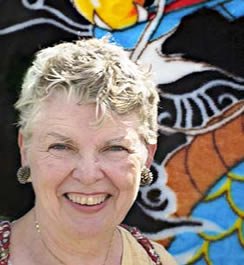University Honors Minnie Bruce Pratt Feb. 26
Poet-activist to retire in June, after decade in A&S

will be the subject of a major celebration, on the eve of her retirement from Syracuse University’s College of Arts and Sciences.
A professor in both
and
Department of Women's & Gender Studies
(WGS), Pratt will be feted on Thursday, Feb. 26, at 4 p.m. in Bird Library’s Peter Graham Scholarly Commons. The program is titled “Writing In-Between, Living In-Between” and includes brief faculty remarks, followed by readings by some of Pratt's former creative nonfiction writing students.
The event is free and open to the public; however, attendees are encouraged to R.S.V.P. to
. A computer-aided real-time translation of the texts being read will be projected on an overhead screen.
“Writing In-Between, Living In-Between” is co-sponsored by The Writing Program; WGS; and the
Lesbian, Gay, Bisexual, and Transgender (LGBT) Studies Program
. The event is also part of the Nonfiction Reading Series and the #Feminisms series, sponsored by The Writing Program and WGS, respectively.
“Minnie Bruce Pratt is a ‘pioneer’ in every respect of the word,” says Gerald R. Greenberg, the College's senior associate dean and associate professor of Russian and linguistics. “As a teacher-scholar, she is a leader in women’s studies, particularly feminist theory. Yet one of her greatest legacies is still unfolding—that of helping establish our LGBT Studies Program.”
In addition to Greenberg, the event includes remarks by Lois Agnew, associate professor of writing and rhetoric, as well as director of The Writing Program; Roger Hallas, associate professor of English and director of LGBT studies; and Vivian May, associate professor and chair of WGS.
“She will be sorely missed at Syracuse, where her insightful pedagogy, political acumen, poetic sensibility, and keen intellect have touched so many of us, whether as her colleagues or as her students,” May says. “Minnie Bruce's compelling poetry and essays have amply shown us all how theoretical and creative insights are perhaps most powerful when they are deeply situated within and speak to the lived realities of everyday life.”
Pratt is known for her groundbreaking work in women’s studies—chiefly, feminist theory and the intersections of race, gender, class, and sexuality; LGBT studies; and creative nonfiction and poetry. At Syracuse, she has been a key architect of the LGBT Studies Program, which launched in 2006, a year after she arrived on campus, and has led to the University being named one of the nation’s top-50 LGBT-friendly institutions, according to Campus Pride.
Pratt also has co-chaired and keynoted numerous academic conferences; has served as an affiliated faculty member in
; and has lent her expertise to major programs and initiatives, including the University’s Future of Minority Studies Project and the
Stone Canoe
arts journal, which the YMCA Arts Branch has recently taken over from University College.
She also participates in the International Action Center and is a contributing editor to
Workers World
newspaper.
Prior to Syracuse, Pratt held faculty positions at Hamilton College; Union Institute and University in Ohio; The University of Maryland; Fayetteville State University in North Carolina; and The University of North Carolina at Chapel Hill, where she earned a Ph.D. in English literature.
Pratt is the author of more than a dozen award-winning or critically acclaimed books, including
The Dirt She Ate: Selected and New Poems
(University of Pittsburgh Press, 2003) and
Crime Against Nature
(Firebrand Books, 1990). An internationally sought-after speaker, she has published dozens of poems, essays, and articles, many of which have been anthologized.
Adds May: “Minnie Bruce's craft as a writer, educator, and scholar should be understood as integral to her commitment to liberation politics: she has taught us how art and activism can be deeply interwoven, just as theory and praxis can be bridged to forge generative change."
Media Contact
Ron Enslin
